✌️ Welcome to the latest issue of The Informationist, the newsletter that makes you smarter in just a few minutes each week.
🙌 The Informationist takes one current event or complicated concept and simplifies it for you in bullet points and easy to understand text.
🧠 Sound smart? Feed your brain with weekly issues sent directly to your inbox here
Today’s Bullets:
- What is TARGET2?
- What are the current balances?
- What are the implications?
- The end of Europe?
Inspirational Tweet:
Good Morning from #Germany where Target2 balance jumped by €79bn in Aug due to rising stress in Eurozone w/10y Italy risk spread way above 200bps! Target2 claims of Bundesbank on rest of Eurosystem now at €1.24tn, €15bn shy of a fresh ATH, meaning substantial risks for Germany pic.twitter.com/o9vm6ci7Cc
— Holger Zschaepitz (@Schuldensuehner) September 9, 2022
A lot of people owe Germany a lot of money. How do we know? TARGET2.
But what exactly is TARGET2 is, why does it matter, and what’s it telling us about possible financial problems within Europe?
Let’s answer all of those, simply and quickly, as always, here.
🎯 What is TARGET2?
First, TARGET is an acronym that stands for Trans-European Automated Real-time Gross Settlement Express Transfer System.
Right. We’ll stick with TARGET.
And 2 just means it’s the second iteration of the payment system implemented by the Eurozone.
Put simply, TARGET2 is the payment system used by Eurozone central banks to quickly settle cross-border payments in real time.
TARGET2 transactions can be for anything from payment for a goods delivery, to the purchase of a security or loan payment, to the simple deposit of funds at a bank.
At the end of each business day, all claims and liabilities are automatically cleared and transferred to the ECB (European Central Bank), leaving each National Central Bank (NCB) with a total liability to, or claim on, the TARGET2 (ECB) balance sheet.
For example:
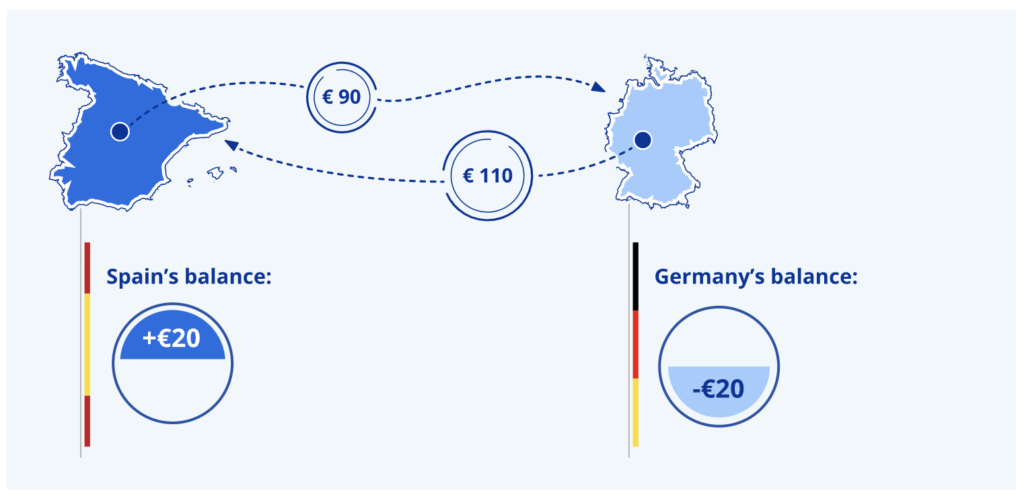
*One Big Key: TARGET2 also settles all ECB monetary policy operations.
TARGET2, therefore, gives us some insight as to which country is borrowing and which is lending, and hence, how the ECB is playing games with strong country balance sheets propping up weaker ones in the Eurozone.
If you’re wondering, we have a similar central bank settlement system here in the US Federal Reserve System called the Interdistrict Settlement Account (ISA). The US participants are the twelve Fed branches. One big difference between TARGET2 and the ISA is that the various balances between the reserve banks are resolved regularly with a settlement.
In contrast, there is no mechanism in place to ensure settlement between Eurozone Central Banks in the TARGET2 system.
The balances are just calculated and noted.
🧐 What are the current balances?
Before 2008, the balances (liabilities and claims) of each central bank remained relatively small. This is partly because of the opaque nature of the original TARGET system that was used up until 2007. The second, and more critical reason is the virtually unlimited credit facilities made available by Eurozone central banks and the ECB after the Great Financial Crisis of 2008.
Then, in March 2020, the ECB further increased purchases under the Asset Purchase Program (APP) and adopted a new program called the Pandemic Emergency Purchase Program (PEPP).
In other words, Quantitative Easing (QE) exacerbated an already growing imbalance between countries with current account surpluses (i.e., Germany) and those with current account deficits (i.e, Italy).
Reminder: current accounts are just a fancy way of saying trade imbalance. If I export more than I import, then I have a surplus, and vice versa.
And so, these QE-style asset purchases have cross-border effects that will cause an increase in TARGET2 balances.
So, where do the balances stand, and can you guess which country is essentially the Central Bank to the rest of the Eurozone? (For a hint, peek at today’s Inspirational Tweet 😜).

You got it. No surprise, Germany is Europe’s sugar daddy.
😨 What are the implications?
We have an expression on Wall Street that goes like this:
If you owe the bank $100,000, it’s your problem, but if you owe the bank $100 million, it’s the bank’s problem.
Germany has a problem.
As the banker to Europe, and with current net claims to the tune of €1.2T, from the other Eurozone countries, Germany is boxed into, fully committed, has little to no recourse, but to continue funding the problem and pushing toward (read: hoping for) a reversal in the needs of deficit running countries.
And the most indebted country is Italy, with a negative TARGET2 balance of €658B.
But did you notice that blue line in the chart above? The one that represents the ECB itself?
That’s right, the ECB has a negative balance of ~€350B, and so it owes Germany, too.
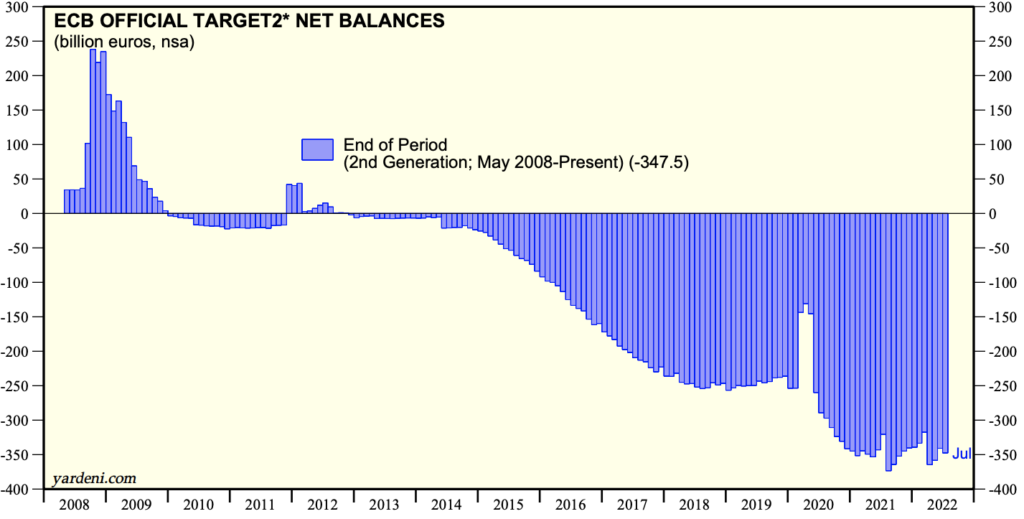
This is the ECB’s idea of free-market monetary policy.
☠️ The end of Europe?
You may ask, if the ECB keeps borrowing from Germany to fund the problem, can they eventually make it better, maybe fix it?
Well.
You know that friend of yours who has an adult kid, maybe in their 30’s or 40’s, and he’s constantly asking for help from his parents, maybe living in their basement, still? And the parents keep giving him money, rationalizing that someday he will be fully independent, he’ll get back on his feet? He’s just going through a rough patch…
Yeah, the parents here are Germany and the kid is actually four: Italy, Spain, Portugal, and Greece.
Today’s main problem child, though, is Italy.
As the ECB faces historic inflation rates and the challenge to tackle them, they’ve been raising the target central bank rates. And this has been putting pressure on countries that have weaker balance sheets, namely the four above. The one who has been in the most trouble recently is Italy.
How can we tell?
Take a look at the spread between the Italian 10-year government bond yields and the comparable 10-year German bund yield:
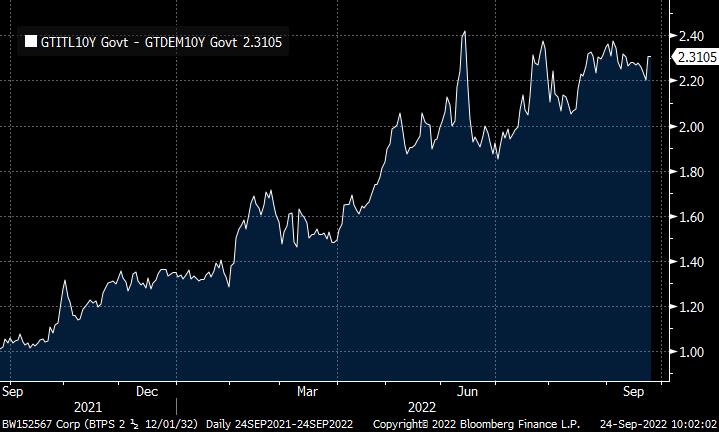
That’s a 2.31% difference in yield for the same duration bond, both domiciled in Europe. And so what it’s telling us is that there’s a perceived higher risk associated with the Italian bond versus the German bond.
It’s also telling us that that risk is increasing as rates go higher and the spread is getting larger.
And then look what happened on Friday:
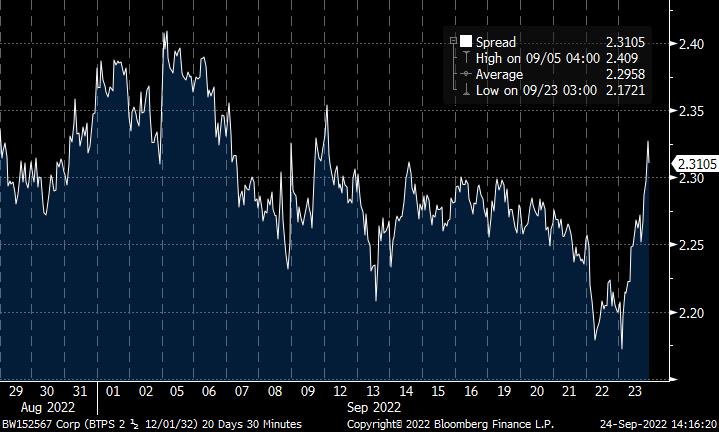
As yields spiked across the UK and Europe, the spread widened significantly.
And if you’ve been paying attention to ECB policy, or if you’ve read the recent 🧠Informationist Newsletter about it, you know that the ECB has announced a new tool they can use to prevent banking problems in weaker countries due to rising rates.
Here’s the article.
For the TL;DR crowd: The Anti-Fragmentation Tool, also known as the Transition Protection Instrument is a sneaky term for Yield Curve Control. And what it means is that the ECB is prepared to buy Italian 10YR bonds (or any other bond or duration from any other country) in order to ‘ensure sufficient liquidity in the markets’. But really, to keep the Italian banks from failing (read the article above if you want more context there).
For what it’s worth, the CDS (Credit Default Swap) spread shows that the fixed income market agrees that Italy has an elevated risk. Notice the rates spiking in July before Lagarde and the ECB announced their new tools to buy Italian bonds to help. Even so, the risk continues to increase along with interest rates, regardless, as you can see here:
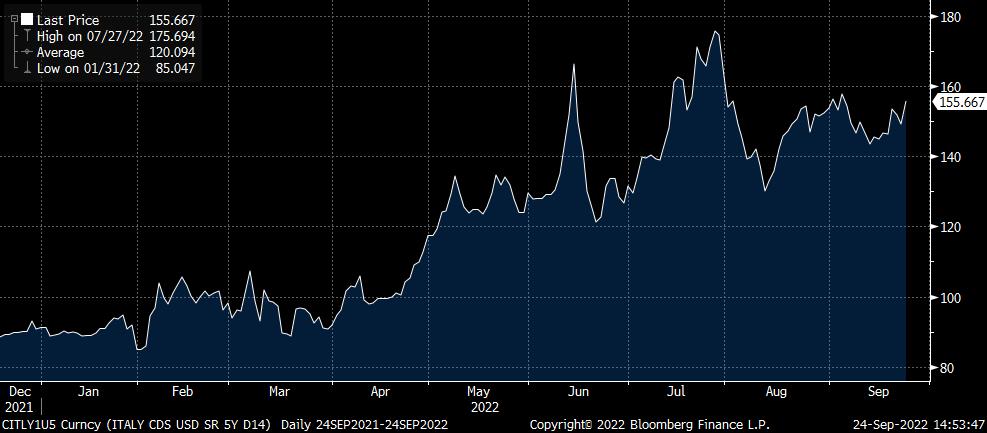
Okay, so what you should gleam from all this is:
The ECB must continue to use QE or yield curve control or whatever they are calling it to manage interest rates in Italy from spiking beyond a certain level and causing a credit crisis there.
That level is estimated to be about -2.3% to -2.4% spread between the Italian and German 10YR bonds.
You got it, we’re right there already.
And so the manipulation continues.
And as TARGET2 imbalances then continue to grow, it becomes less and less likely that the ECB can ever engineer a reversal and actually settle out the balances for each member country.
And this, my friends, is what I believe will be the oak tree that breaks the proverbial camel’s back.
When?
I don’t profess to know that, as these things can drag on for many months and years. But I would say that if this continues on as is, the European Union will break apart, as Germany makes the decision to swallow its losses and move on, leaving the EU.
And I think that happens within the decade.
That’s it. I hope you feel a little bit smarter knowing about TARGET2 and how it shows us some of the financial problems Europe is facing.
Before leaving, feel free to respond to this newsletter with questions or future topics of interest. And if you want daily financial insights and commentary, you can always find me on Twitter!
Thanks again and talk soon!
✌️James










